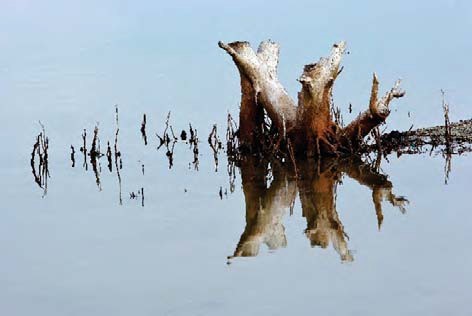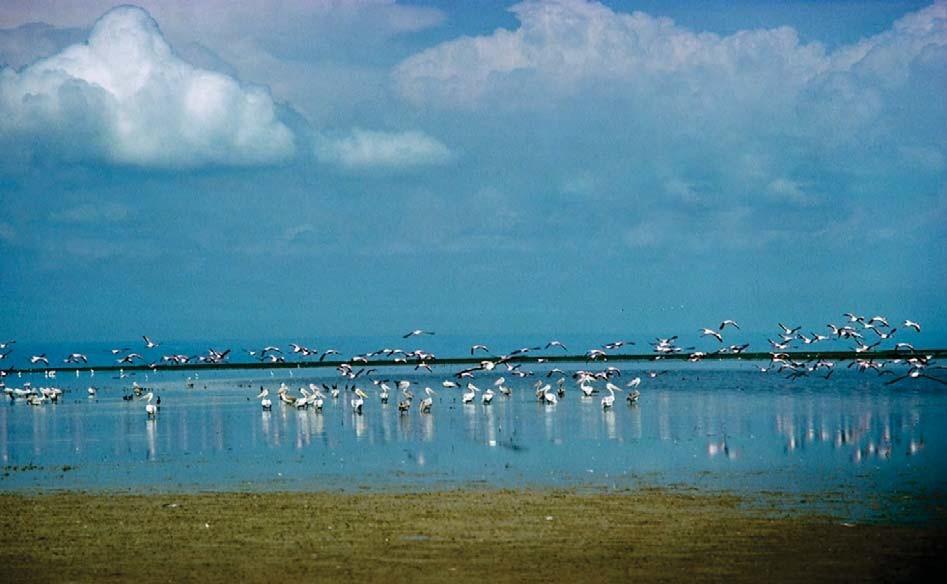![]()
The Cowrie – SIDS Times Magazine Fall 2017 Online Edition – Back to Table of Contents

PHOTO CREDIT – UN PHOTO/MARTINE PERRET
The Wider Caribbean region is one prone to natural hazards and technological disasters. Active hurricane seasons and sometimes large amounts of rainfall often result in severe flooding and damage to infrastructure, which in turn, affects economic growth and productivity.
Infrastructure, agriculture and production are all industries that are essential to life in the Caribbean. Tourism and fishing, industries which are dependent on the region’s rich biodiversity and even more essential to its economy, often bear the brunt of the damage during natural disasters.
Fortunately, the Wider Caribbean also possesses rich natural resources that can help to mitigate and even minimize the impact of disasters. One such natural resource is its wetlands.
An important source of fresh water for humanity and home to more than 100,000 freshwater species, which continue to increase in number; the Caribbean region is blessed with various wetland types such as: marshes, lagoons, swamp forest, mangroves, corals, rivers and other coastal wetlands.
Their functions include providing habitat for biodiversity, both animals and plants, with the added benefit of purifying waterways through a natural filtering system and storing water for future use. This ensures a clean and constant water supply.
Caribbean wetlands also play an important function, that of disaster mitigation as they control and regulate the flow of water, protect shorelines from coastal surges during hurricanes, absorb excess rainfall to reduce flooding, and provide windbreaks. In essence, Caribbean coastal areas have a natural, protective buffer from hurricane and storm damage.
However, there is bad news for regional and worldwide wetlands.
Mangroves, wetlands and coral reefs have proven to be some of the most degraded ecosystems in Latin America and the Caribbean. Threats such as burning, overfishing, pollution, housing developments on swamp lands, drainage through agriculture, as well as the cutting down of trees for timber and charcoal result in the loss of valuable ecosystem services, such as sewage treatment by mangrove wetlands systems and the eco-tourism essential for many Caribbean economies.
Scientific estimates show that 64% of the world’s wetlands have disappeared since the 1900s and the remaining ones are being degraded faster than any other ecosystem.
Mangrove forests too, are disappearing at a rate of 1 to 2 percent per year, a pace that surpasses the destruction of adjacent coral reef and tropical rainforests.
A survey of 220 Eastern Caribbean coastal wetlands (predominantly mangroves) between 1989 and 1991 revealed that virtually every site visited in the 16 islands showed evidence of damage, and more than 50 percent showed severe damage (Bacon 1993).
As a result, these losses, combined with increasing fragmentation of mangroves reduce their viability and the quality of the services they provide.
Overall, the region is losing mangrove forests at 1 percent per year, although the rate is much faster on the Caribbean mainland (1.7% per year) than it is on the islands (0.2% per year). The region’s fisheries are declining at a similar rate, as most commercial shellfish and finfish use mangal for nurseries and/or refugia.
Further to this, few Caribbean states have legislation or enforcement capabilities to protect or manage mangal, although at least 11 international treaties and conventions could be applied to conserve or sustainably use these forests
If wetlands are allowed to function as intended, then Caribbean governments could avoid spending millions in the restoration process following disasters. By serving as a source of food or income, wetlands enable local communities to be more resilient and less vulnerable to disasters.
The Wider Caribbean region stands to benefit from conservation and protection of their wetlands; whether as a source of energy/food, recreation/tourism opportunity, and waste-water treatment facility or simply for its aesthetics.
On a more positive note, Caribbean countries such as Anguilla, Aruba, Montserrat, Saint Lucia, and the Turks and Caicos Islands have maintained their mangrove areas relatively constant over the past 25 years. As a result of increased awareness in the region, the annual rate of mangrove area loss has decreased in the last five years in 24 countries within the Caribbean.
The Ramsar Convention and UN Environment’s Caribbean Environment Programme through its Specially Protected Areas and Wildlife (SPAW) protocol continue to work with several local, national and regional groups and organizations to conserve and sustainably manage the use of wetlands and their resources; yet national commitments have to be made to reduce the threat of humans on wetlands.
Every country and citizen can get involved in the conservation of Caribbean wetlands through simple activities such as bringing an end to the draining or filling of wetlands, clearing of mangroves for agricultural purposes and housing developments, destroying coral reefs, and burning of peatlands.

PHOTO CREDIT – UN PHOTO/B WOLFF
Local and regional environmental groups can be supported as they seek to protect and conserve the region’s natural resources. Commitment can be made to simple actions to preserve wetlands by saving water, recycling garbage and reducing harmful waste, use as little fertilizer as possible and avoid the use of toxic pesticides.
The preservation of wetlands is everybody’s business.
Co-authored by
Deonne Smith (deonne.smith@unep.org) Communication and Partnerships Officer
UN Environment Caribbean Sub-Regional Office
Sancha Foreman (sf@cep.unep.org) Team Assistant
UN Environment Caribbean Sub-Regional Office